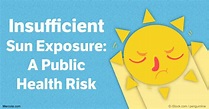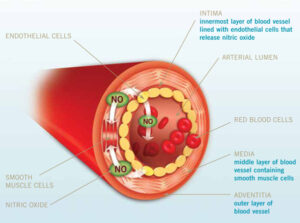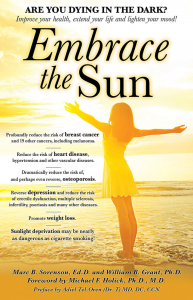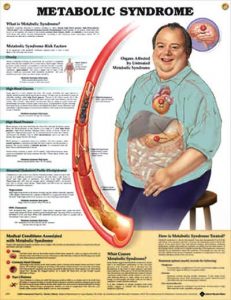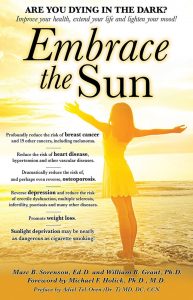Mood is essential to a happy life and wellbeing. By Marc Sorenson, EdD
Mood (a good mood) is critical to optimal living, and those who work in natural light experience improvement. In addition, a good mood leads to better performance, behavior and psychological health.  Furthermore, very few things improve wellbeing like arising early in the morning and walking outside on a sunny day: Our attitude improves too, and our serotonin and endorphin levels increase. Consequently, there is an almost immediate feeling of exhilaration. So, we become happier and less confrontational, and our minds seem to click on all cylinders. This mood change is all due to the morning sun exposure. Does midday sun exposure also help?
Furthermore, very few things improve wellbeing like arising early in the morning and walking outside on a sunny day: Our attitude improves too, and our serotonin and endorphin levels increase. Consequently, there is an almost immediate feeling of exhilaration. So, we become happier and less confrontational, and our minds seem to click on all cylinders. This mood change is all due to the morning sun exposure. Does midday sun exposure also help?
Mood and midday sunlight
Later on, around midday, we produce large quantities of vitamin D, and our nitric oxide levels increase. That is, of course, if we are fortunate enough to safely sunbathe (with a lot of skin exposed). As a result, we experience a delicious feeling of relaxation and a lowering of blood pressure as the cares of the day melt away. Therefore, mood is again enhanced.
Mood and sun robbery
Regrettably, due to various factors, most of us live in a society robbed of the sun. We are confined to artificially lighted buildings and poor little cubicles and our mood is crushed. These little cubicles, of course, seem like prison cells that won’t allow our happiness to manifest itself.
Consequently, concerned scientists are recognizing that modern humans suffer from artificial, insufficient light in their lives. So these scientists are advocating a return to natural light. One of their studies on the subject of light and mood is most noteworthy. They, due to their concern about light availability measured the impact of windows and daylight on mood. They studied the physiological, psychological and behavioral health of working nurses.[1] First of all, they used biological measurements, behavioral mapping and data analysis in a nursing unit of two wards. While both wards exhibited similar conditions, one ward had more windows and more natural lighting than the other.
Impressive mood results:
As a result, in the ward with more windows and natural light, the nurses had better health. They had lower blood pressure and higher body temperature, less sleepiness and a better mood. Communication and laughter also increased. Heart rates were shown to be lower with greater exposure to light, and caffeine intake was reduced as well. In conclusion, mood was improved, as was performance. Rana Zedeh, the lead researcher of that study, made the following statement:[2] “Research has shown a range of different outcomes are impacted by sun, including regulation of the circadian rhythm, shorter length of stay for patients, reduced perception of pain for patients, and reduced anxiety and agitation among elderly patients with dementia. Improved outcomes for patients also help staff manage their patients better.”
Change the environment, change the mood.
Finally, one can only imagine the potential benefits that could be realized if unencumbered sun rays are allowed. Vitamin D production would increase, and it is likely that patients as well as nurses would improve their health.
Hence, Dr. Zadeh also made this declaration: “Intelligently designed clinical workspaces could lead to higher safety and quality levels… By default, when we think of a healthcare workspace, we may think of a large, deep building with no windows for staff, little access to greenery or outdoors, an institutional feel, complex way-finding, and monotonous color and lighting. Knowing how the human brain receives stimuli from the environment and constantly changes neural hormonal responses controlling cognitive performance and alertness, we might be able to improve outcomes by creating more vigilant and restorative elements in environments.”[3] The translation is, “elevate your mood by getting out of the little dark boxes and back into the sun.”
 How does the sun work to improve mood?
How does the sun work to improve mood?
First of all, what does the sun do to relieve “the blues?” The answer lies in a chemical responsible for transmitting impulses between nerve cells. This “neurotransmitter,” serotonin, is a natural “upper,” working in synchronization with the natural “downer,” melatonin. So, when we awake to sunshine, light enters the eye and stimulates serotonin production. Because of this reaction, sunlight can dramatically increase serotonin levels in the brain and immediately improve mood.
Dr. Gavin Lambert and his colleagues in Australia measured serotonin levels in response to varying degrees of bright light. [4] To do so, they drew blood samples from the internal jugular veins of 101 men and compared the serotonin concentrations of the blood to weather conditions and seasons. The remarkable results: Men who were measured on a bright day produced eight times more serotonin. That is, compared to those who were measured on a dismal day. Of course, the mood was improved due to sunlight.
Get your regular, non-burning sun exposure and enhance your good mood!
[1] Zadeh RS, Shepley MM, Williams G, Chung SS. The impact of windows and daylight on acute-care nurses’ physiological, psychological, and behavioral health. HERD 2014 Summer;7(4):35-61.
[2] Katy Mena-Berkley. Mood: the Science of Letting the Sunshine In. MD News
[3] Katy Mena-Berkley. Mood: the Science of Letting the Sunshine In. MD News
[4] Lambert GW, Reid C, Kaye DM, Jennings GL, Esler MD. Effect of sun and season on serotonin turnover in the brain. Lancet. 2002 Dec 7;360(9348):1840-2.
Marc Sorenson, EdD, for breast cancer prevention. 
While many doctors know that ultraviolet radiation (UVR) from sunlight reduces risk of breast cancer, they have missed something. UVR stimulates production of vitamin D in human skin. Therefore, many health professionals assume that vitamin D is responsible for the reduced cancer risk. This may lead them to advocate the use of vitamin D supplementation and totally miss the bigger picture. In addition to vitamin D, UVR from sunlight or sunlamps produces many supplementary healthful photoproducts. Among others, nitric oxide, serotonin, endorphin and BDNF are produced by sunlight, and these photoproducts are vital to health. And, it is likely that these healthful photoproducts lead to an inhibition of breast cancer.
New research shows that sun exposure per se is capable of reducing the risk of breast cancer.
Consequently, it should not surprise us that for breast cancer, sunlight’s effects go beyond vitamin D.[1] Researchers at Children’s Hospital Oakland Research Institute, used a murine model (mice) that easily develops breast cancer, and treated them with UVR. Much as we might expect, they found that UVR treatments produced significant anti-cancer effects. Furthermore, they found that neither dietary vitamin D nor topical vitamin D influenced cancer risk. Because of their findings, they stated the following: “UVR’s inhibitory effects occur irrespective of whether or not the treatment increases circulating D3 in the mice.” Also, they made one more important comment regarding their research on breast cancer and UVR. “Therefore, supplemental D3 may not mimic all possible beneficial effects of UVR, and uncovering non-D3-mediated mechanisms of UVR tumor inhibition may lead to novel strategies for cancer prevention.”
An important point about vitamin D, sunlight and breast cancer.
Finally, there is no doubt that vitamin D has anticancer benefits. This research however, is especially relevant in that it corroborates what I have said in my soon-to-be-released book, Embrace the Sun. First of all, we must not put all of the benefits of sunlight in the vitamin D box. Secondly, sun exposure performs myriad miracles beyond vitamin D. One of those miracles may be breast cancer prevention and inhibition. Thirdly, if we erroneously believe that we can obtain all of the sun’s benefits from popping a vitamin D pill, we may miss the holistic effects of the sun, which provide a cornucopia of salubrious results.
So, safely (without burning) embrace the sun and ease your mind about breast cancer.
[1] Anastasia M. Makarova, Flora Frascari, Parastoo Davari, Farzam Gorouhi, Philip Dutt, Lynn Wang, Akash Dhawan, Grace Wang, Jeffrey E. Green, Ervin H. Epstein, Jr. Ultraviolet radiation inhibits mammary carcinogenesis in an ER negative murine model by a mechanism independent of vitamin D3. Downloaded from cancerpreventionresearch.aacrjournals.org on April 12, 2018.
 Although liver cancer is generally thought to be related to drinking, other factor such as obesity, HIV infection, smoking, diabetes, socioeconomic factors, drugs and others come into play. A recent study compared sun exposure to liver cancer and adjusted for the aforementioned factors. Sun exposure was shown to be a major factor in reducing the risk of the most prevalent and deadly liver cancer, called hepatocellular carcinoma.[1]
Although liver cancer is generally thought to be related to drinking, other factor such as obesity, HIV infection, smoking, diabetes, socioeconomic factors, drugs and others come into play. A recent study compared sun exposure to liver cancer and adjusted for the aforementioned factors. Sun exposure was shown to be a major factor in reducing the risk of the most prevalent and deadly liver cancer, called hepatocellular carcinoma.[1]
Major finding for liver cancer:
The subjects were divided into five groups, or quintiles, based on their sun exposure. In addition such factors as as outdoor activity, geographical residence, urban or rural settings, etc. were adjusted for.
Most noteworthy, was the fact that for each quintile of increasing sun exposure, there was a 17% decrease in the liver cancer risk.
A disappointment:
The only disappointing part to the study was this: The researchers assumed that the positive influence of sun exposure on liver cancer was due to vitamin D production. And, they may have been correct. Yet the sun causes the body to produce many other photoproducts. Due to the sun’s myriad effects, serotonin, endorphin, BDNF, nitric oxide, and dopamine are all increased. Therefore, it is impossible to know if vitamin D alone was the reason for the reduced risk of liver cancer. However, vitamin D undoubtedly played a large part in the positive results. And, there is a problem with giving vitamin D the credit without knowing for sure. People may believe, due to this research, that they need only to take a vitamin D supplement to receive all benefits of sunlight. Therefore, they can make very bad assumptions.
This is the first study on sun exposure and liver cancer.
Probably, this is the first research to show a link between liver cancer and inadequate sun exposure. However, there are indications that sun exposure is associated with a reduced risk of another liver ailment, called fatty liver disease.[2]
In conclusion, if you are a liver lover, you can love your liver by protecting it from liver cancer. Hence, you should obtain your share of unscreened, direct, non-burning sun exposure. Happy sunning!
[1] Trang VoPham, Kimberly A. Bertrand, Jian-Min Yuan, Rulla M. Tamimi, Jaime E. Hart,
and Francine Laden. Ambient ultraviolet radiation exposure and hepatocellular carcinoma incidence in the United States. Environmental Health (2017) 16:89.
[2] Gorman S, Black LJ, Feelisch M, Hart PH, Weller R. Can skin exposure to sun prevent liver inflammation? Nutrients 2015 May 5;7(5):3219-39.
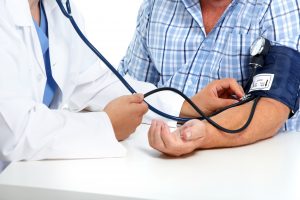 Blood pressure is determined by (1) the amount of blood the heart pumps and the amount of resistance to blood flow in the arteries. Consequently, the more blood the heart pumps, and the tighter the arteries, the higher the blood pressure.[1]
Blood pressure is determined by (1) the amount of blood the heart pumps and the amount of resistance to blood flow in the arteries. Consequently, the more blood the heart pumps, and the tighter the arteries, the higher the blood pressure.[1]
Chronic high blood pressure, or hypertension, can damage arterial walls and can eventually lead to an increased risk from heart disease, heart failure, other arterial diseases, kidney disease, irregular heart rhythms, osteoporosis, cognitive dysfunction, painful intercourse and stroke.[2] High blood pressure, also known as hypertension, is rampant in western societies. Untreated high blood pressure is a major killer. It is especially dangerous because it is primary risk factor for heart disease and stroke.
I have written several blogs on high blood pressure. Nevertheless, the experience of my friend Wayne may provide impetus for hypertension sufferers to try the sunshine solution.
Wayne, a resident of Texas, came to our former health resort seeking help for conditions of high blood pressure, obesity and various other maladies. I recommended, along with our healthful nutrition program, that he should sunbathe daily. Consequently, he “took it to heart” and could be found outside by the pool daily, dutifully soaking up the midday sunlight.
Wayne arrived at our program with a blood pressure of 157 systolic and 97 diastolic (157/97). Most noteworthy, those numbers put him at high risk for a stroke. Normal blood pressures are considered below 120 systolic, and below 80 diastolic. Four weeks later, as a result of his lifestyle changes. His numbers dropped to 125/54, meaning that he progressed from high stroke risk to very low stroke risk. Especially relevant is the fact that these changes were accomplished without medication.
The average drop in blood pressure among all guests at that program was 16 systolic and 12 diastolic. This is remarkable, considering that many of them had normal levels coming in.
Here are just a few of the blood pressure changes accomplished during that time:
- Frieda, from Oregon, lowered her blood pressure 33 points systolic and 30 points diastolic.
- Joyce, from Rhode Island, lowered her blood pressure 31 points systolic and 24 points diastolic.
- Jeff, from Utah, lowered his blood pressure 39 points systolic and 12 points diastolic.
- Susan, from New York, lowered her blood pressure 20 points systolic and 26 points diastolic.
Was all of this success due to sun exposure?
It should not be construed that these results were all a result of sun exposure. Nor should we conclude that hypertension is a result of sun deprivation. Typical American citizens engage daily in “killer” nutrition, subjecting themselves to dietary patterns and chemical additives that never existed in human life until modern times. Therein lie the major causes of hypertension. Hence, part of the improvements in blood pressure were due to the dietary changes we implemented with our guests.
More research regarding sunlight and blood pressure:
Sun exposure can, to an extent, act as an antidote to the poisons we consume. And, it acts much more quickly than dietary changes. Consider this: Dr. Oplander and his colleagues demonstrated that whole-body Ultraviolet A (UVA) irradiation worked what seemed like a miracle.[3] It caused a rapid, significant decrease of 11% in both systolic (upper number) and diastolic (lower number) blood pressure 30 minutes after the exposure. That change lasted up to 60 minutes. The lowered blood pressure lasted up to 60 minutes. Not only did blood pressure decrease, but arterial blood flow increased by 68%.
Nitric oxide, a potent vasodilator (blood-vessel relaxer) that occurs with sun exposure, was the photoproduct that led to these spectacular, important changes. This is important, because UVA is available almost any time the sun shines, winter and summer. Ultraviolet B (UVB) is not available in some areas during winter, due to the sun’s angle. This is especially true in the higher latitudes of the Northern hemisphere, or in the lower latitudes of the Southern hemisphere. UVB stimulates the production of vitamin D. So, it is especially relevant here that vitamin D was not involved in the lowering of blood pressure in Dr. Oplander’s study. Nitric oxide, however, was very involved.
Let’s take a look at one more study of sun exposure and hypertension: research China demonstrates that exposure to sun correlates to a lowered risk:[4] In a randomly selected population of Chinese residents from Macau (where the rate of hypertension is very high), the following risk factors for hypertension were assessed: lack of sun exposure, low intake of fish, smoking, obesity and lack of exercise. An average of more than one-half hour of sun exposure per day, as compared to no sun exposure, predicted a 40% reduced risk for hypertension.
I could go on for another page about the horrors of blood-pressure medication, but what I have said suffices. Non-burning sun exposure is one of the best elixirs for hypertension. In conclusion, one might say that it is no wonder that Wayne overcame his blood pressure problem!
[1] Mayo Clinic Diseases and Conditions: High blood pressure (hypertension). http://www.mayoclinic.org/diseases-conditions/high-blood-pressure/basics/definition/con-20019580 (accessed January 5, 2016).
[2] Ann Pietrangelo. Healthline 2014 http://www.healthline.com/health/high-blood-pressure-hypertension/effect-on-body (accessed January 4, 2016).
[3] Opländer C, Volkmar CM, Paunel-Görgülü A, van Faassen EE, Heiss C, Kelm M, Halmer D, Mürtz M, Pallua N, Suschek CV.. Whole body UVA irradiation lowers systemic blood pressure by release of nitric oxide from intracutaneous photolabile nitric oxide derivates. Circ Res. 2009;105:1031–40.
[4] Ke L, Ho J, Feng J, Mpofu E, Dibley MJ, Feng X, Van F, Leong S, Lau W, Lueng P, Kowk C, Li Y, Mason RS, Brock KE. Modifiable risk factors including sun exposure and fish consumption are associated with risk of hypertension in a large representative population from Macau. J Steroid Biochem Mol Biol 2013 Nov 1 [Epub ahead of print].
Hypertension, or chronic high blood pressure, is determined by the amount of blood the heart pumps and the amount of resistance to blood flow in the arteries. The more blood the heart pumps and the tighter the arteries, the higher the blood pressure.[1] The top number on a blood-pressure measurement, stated in millimeters of mercury (mm/Hg), is called systolic pressure, and the lower number is called diastolic pressure. Hypertension is defined as having a blood pressure > 140/90 mm/Hg. 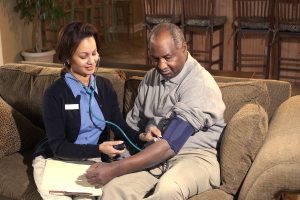 Thirty-one percent of US adults are hypertensive.[2] Hypertension can damage arterial walls and can eventually lead to an increased risk of death from heart disease, heart failure, and other arterial diseases. It is also associated to a higher risk of kidney disease, irregular heart rhythms, osteoporosis, cognitive dysfunction, painful intercourse and stroke.[3] Conventional textbook theory holds that blood pressure is regulated by the brain, blood vessels, or kidney, but recent evidence suggests it could be regulated in the skin, and sun exposure plays a role in controlling hypertension.[4]
Thirty-one percent of US adults are hypertensive.[2] Hypertension can damage arterial walls and can eventually lead to an increased risk of death from heart disease, heart failure, and other arterial diseases. It is also associated to a higher risk of kidney disease, irregular heart rhythms, osteoporosis, cognitive dysfunction, painful intercourse and stroke.[3] Conventional textbook theory holds that blood pressure is regulated by the brain, blood vessels, or kidney, but recent evidence suggests it could be regulated in the skin, and sun exposure plays a role in controlling hypertension.[4]
One of the earlier studies of hypertension and sun showed hypertension increased linearly at increasing distances from the equator.[5] One study of hypertensive subjects shows that blood pressure levels average 165/90 in winter but 134/74 in the summer, and both stroke and heart attack rates double in the winter.[6] Even in children, blood pressure is higher in winter than summer.[7] This, of course, is indicative of a protective role of sun exposure on hypertension.
UVB light treatments with sun lamps have also been shown to substantially lower blood pressure in 24 hours, and over six weeks to raise serum 25(OH)D levels of vitamin D by 162%, while lowering both systolic and diastolic pressure by six points.[8]
However, it is important to again mention that there is another important player in the relationship between hypertension and sun. Ultraviolet A (UVA) light (part of sunlight) stimulation of the skin causes the release of nitric oxide (NO) from pre-formed stores of NO in the skin. NO is a potent vasodilator, and when released into the arteries by UVA stimulation, causes increased blood flow and lowered blood pressure.[9], [10]
Safe sun exposure, along with plenty of vegetable and fruit consumption, may enable you to say goodbye to blood-pressure problems.
[1] Mayo Clinic Diseases and Conditions: High blood pressure (hypertension). http://www.mayoclinic.org/diseases-conditions/high-blood-pressure/basics/definition/con-20019580 (accessed January 5, 2016).
[2] Fields LE, Burt VL, Cutler JA, Hughes J, RoccellaEJ, Sorlie P. The burden of adult hypertension in the United States 1999–2000: a rising tide. Hypertension. 2004;44:398–404.
[3] Ann Pietrangelo. Healthline 2014 http://www.healthline.com/health/high-blood-pressure-hypertension/effect-on-body (accessed January 4, 2016).
[4] Johnson RS, Titze J, Weller R. Cutaneous control of blood pressure. Curr Opin Nephrol Hypertens. 2016;Jan25(1):11-5.
[5] Rostand SG. Ultraviolet light may contribute to geographic and racial blood pressure differences. Hypertension. 1997 Aug;30(2 Pt 1):150-6.
[6] Charach G, Rabinovich PD, Weintraub M. Seasonal changes in blood pressure and frequency of related complications in elderly Israeli patients with essential hypertension. Gerontology. 2004 Sep-Oct;50(5):315-21
[7] Polat M, Akil I, Yuksel H, Coskun S, Yilmaz D, Erguder I, Onag A. The Effect of seasonal changes on blood pressure and urine specific gravity in children living in Mediterranean climate. Med Sci Monit2006;12:CR186-90.
[8] Krae R, Bühring M, Hopfenmüller W, Holick MF, Sharma AM. Ultraviolet B and blood pressure. Lancet 1998;352:709-10.
[9] Liu D, Fernandez BO, Hamilton A, Lang NN, Gallagher JM, Newby DE, Feelisch M, Weller RB. UVA irradiation of human skin vasodilates arterial vasculature and lowers blood pressure independently of nitric oxide synthase. J Invest Dermatol. 2014 Jul;134(7):1839-46.
[10] D Liu, BO Fernandez, NN Lang, JM Gallagher, DE Newby, M Feelisch and RB Weller. UVA lowers blood pressure and vasodilates the systemic arterial vasculature by mobilization of cutaneous nitric oxide stores. Photobiology Abstract # 1247 May 2013.
Sun Exposure and health by Marc Sorenson, EdD…
A very interesting study has been completed in a remote area of South America.
An indigenous tribe from the remote Bolivian Amazon jungle, known as the Tsimane, has been found to have the world’s healthiest arteries.[1] People there survive on a diet low in saturated fats and high in non-processed foods. One of the researchers stated that “Our study shows that the Tsimane indigenous South Americans have the lowest prevalence of coronary atherosclerosis of any population yet studied.”
Here are some of the lifestyle habits and facts regarding the Tsimane.
- The diet is fiber rich.
- The diet is approximately 75% non-processed carbohydrates. Isn’t that supposed to make us fat?
- The diet includes rice, plantain (a type of banana), corn, nuts, and a very small amount of animal meat.
- Smoking is almost non-existent.
- Only three per cent of the people had moderate to high heart disease risk; two-thirds of them over 75 years of age had virtually no risk. The article states that only 14% of Americans had no risk, and that half had a moderate or high risk—about 5 times higher than the Tsimane.
- Men spend six to seven hours of their day being physically active, whereas women spend four to six hours. This, of course, means plenty of sun exposure.
During most of my professional career, I have advised people to live on this type of diet, but without the meat or any other animal product. In addition we helped them to exercise several hours daily outside. During that time, my wife and I have observed that people have recovered from diabetes, heart disease, arthritis and other maladies. That is no surprise, considering this new research and many other studies. Vitamin D and nitric oxide, both photoproducts, are exceptionally important to human health, but when it comes to heart disease, nitric oxide is probably the operative photoproduct. Here is a quote from Dr. Richard Weller, a common-sense dermatologist and great researcher:
“Sunlight may have beneficial cardiovascular effects, independently of Vitamin D production. Vitamin D could in these circumstances act as a marker for sunlight exposure and its postulated beneficial effects.” “These recent human data show the physiological relevance of photorelaxation. High blood pressure is the leading cause of disability adjusted life years lost worldwide and as a risk factor underlies 18% of all deaths.” The study noted: “The action spectrum of nitrite release shows that ultraviolet B is also involved in nitrite reduction to Nitric Oxide, and thus sunlight may be more effective than a pure UVA source.” The study concluded: “the prevalence of cardiovascular and cerebrovascular deaths is around 100 times higher than those from skin cancer. Interventions leading to small changes in the incidence of cardiovascular disease are thus of greater benefit to the health of the public even than large changes in skin cancer incidence.”[2]
The Tsimane, therefore, are living (unknowingly) an almost perfect lifestyle for optimal health. To stay well, it is imperative that we do the same, although we don’t need quite that much sun exposure. Remember to build up a tan and be safe in the sun.
[1] http://www.mirror.co.uk/science/proof-modern-life-really-kill-10047382
[2] Weller R. The health benefits of UV radiation exposure through vitamin D production or non-vitamin D pathways. Blood pressure and cardiovascular disease. Photochem. Photobiol. Sci. 2016, DOI: 10.1039/C6PP00336B.
The necessity of sun exposure for heart health, by Marc Sorenson, EdD…
Despite the fact that higher vitamin D levels are nearly always found to be related to reduced risk of cardiovascular disease[1] and associated diseases such as diabetes mellitus,[2] randomized controlled trials have not found that vitamin D supplementation reduces risk of cardiovascular disease.[3]
Therefore, vitamin D levels are likely a surrogate measurement for sun exposure, meaning that some other photoproduct such as nitric oxide (NO) may be responsible for the lowered risk of CVD. A pair of recent papers reported that leisure-time or recreational outdoor physical activity was significantly associated with reduced risk of cardiovascular disease. In a study in the U.S., both frequency and intensity of outdoor activities were associated with reduced risk, as was higher vitamin D level.[4] When vitamin D levels were removed from the equation, an inverse association was still found between outdoor recreational activity and mortality. The authors stated the following: “The underlying mechanism for this association may not involve 25(OH)D hence, further studies are warranted to confirm and investigate the underlying mechanism.” I would suggest that nitric oxide was the protective photoproduct, produced by sun exposure, which lessened the risk of CVD with outdoor activity.
Similar findings have been found for hypertension, diabetes mellitus, heart failure, stroke, and myocardial infarction (heart attack). In a study in Finland, older adults who had moderate leisure-time activity had 30-40% reduced mortality and cardiovascular disease rates than those with low activity levels, while those with high activity levels had 50% lower rates.[5]
Two messages from this research: (1) Start living more of your life outdoors. (2) Be sure to obtain plenty of non-burning sun exposure during you outdoor activity. Your life may depend on it.
[1] Wang L, Song Y, Manson JE, Pilz S, März W, Michaëlsson K, Lundqvist A, Jassal SK, Barrett-Connor E, Zhang C, Eaton CB, May HT, Anderson JL, Sesso HD. Circulating 25-hydroxy-vitamin D and risk of cardiovascular disease: A meta-analysis of prospective studies. Circ Cardiovasc Qual Outcomes. 2012 Nov 1;5(6):819-29.
[2] Song Y, Wang L, Pittas AG, Del Gobbo LC, Zhang C, Manson JE, Hu FB. Blood 25-hydroxy vitamin D levels and incident type 2 diabetes: a meta-analysis of prospective studies. Diabetes Care. 2013 May;36(5):1422-8.
[3] Veloudi P, Jones G, Sharman JE. Effectiveness of vitamin D supplementation for cardiovascular health outcomes. Pulse 2016;4:193-207 https://www.karger.com/Article/FullText/452742
[4] Donneyong MM, Taylor KC, Kerber RA, Hornung CA, Scragg R. Is outdoor recreational activity an independent predictor of cardiovascular disease mortality – NHANES III? Nutr Metab Cardiovasc Dis. 2016 Aug;26(8):735-42.
[5] Barengo NC, Antikainen R, Borodulin K, Harald K, Jousilahti P. Leisure-Time Physical Activity Reduces Total and Cardiovascular Mortality and Cardiovascular Disease Incidence in Older Adults. J Am Geriatr Soc. 2016 Dec 26. doi: 10.1111/jgs.14694. [Epub ahead of print]
By Marc Sorenson, EdD, for sun exposure…
A new research paper on sun exposure and cancer has some interesting observations and some errors.[1] It is entitled, Does Sunlight protect us from cancer? Here is the abstract of the article, verbatim.
“The Ultraviolet (UV) radiation contained in sunlight is a powerful mutagen and immune suppressant which partly explains why exposure to solar UV is the biggest risk factor for the development of cutaneous tumors. Evidence is building that sunlight may be protective against some internal malignancies. Because patients with these tumors are often vitamin D deficient, this has led some to propose that vitamin D supplementation will be beneficial in the treatment of these cancers. However, the results from already completed trials have been disappointing which has given weight to the argument that there must be something else about sunlight that explains its cancer-protecting properties.”
The first sentence, of course, is false. The idea, that sun exposure is the biggest risk factor for skin cancer, is erroneous. We have presented materials many times, proving that melanoma is not caused by sun exposure, and that sun exposure is protective against that disease. And as regards common skin cancers, we have shown that high-fat nutrition, lack of antioxidants, meat consumption and alcohol intake are all risk factors. Search the blogs on this site to read the different articles.
The statement is correct, of course, that sunlight is protective against many internal cancers. Dr. Bill Grant and I are finishing our book, Embrace the Sun, where we present nearly all of the research on the protective influence of sun exposure against cancer.
The statement that vitamin D research has been disappointing is both true and false. Randomized controlled studies (RCTs) have shown the vitamin D supplements do have a protective effect against internal cancers, contrary to the statement by the researchers.
Finally, let’s look at the statement that there is something beyond vitamin D that explains the cancer-protecting properties of sun exposure. That is partially true. Beyond vitamin D, the sun causes the production of nitric oxide, serotonin, endorphin and BDNF, all of which are vital to human health, and may have their own cancer-protective properties.
The bottom line? Eat correctly (avoid junk), REGULARLY soak up some sun around midday and get plenty of exercise. That advice will be a boon to your health in myriad ways.

